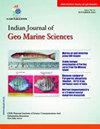哥达瓦里红树林的时空变化:土地利用变化与可持续管理研究
IF 0.5
4区 地球科学
Q4 Earth and Planetary Sciences
引用次数: 0
摘要
利用地理空间方法探讨了印度安得拉邦戈达瓦里红树林土地利用变化的社会经济和环境方面。通过卫星图像发现了红树林的大规模变化。还利用GPS收集了社会经济信息,并对环境变化进行了检查和关联。此外,还记录了降水、温度、淡水流量、地貌和地形等与戈达瓦里红树林变化有关的参数。从1977年到2012年的35年间,红树林面积从15024公顷增加到19694公顷,表明政府和私人造林措施取得了成功。在村庄进行的一项社会经济调查显示,57%的人口认为红树林面积扩大的主要原因是恢复活动和自然现象,而37%的人认为红树林面积减少是由于水产养殖、农业、非法采伐、当地消费和工业活动增加,而其余6%的人认为红树林面积减少。本文章由计算机程序翻译,如有差异,请以英文原文为准。
Spatio-temporal changes in the Godavari mangroves: A study examining land-use change and sustainable management
Geospatial approaches were used to explore the socio-economic and environmental aspects of land use changes in the mangroves of Godavari, Andhra Pradesh, India. Large-scale changes were discovered through satellite images in mangroves. Socio-economic information was also gathered using GPS and environmental changes were examined and correlated. Additional parameters were recorded, including precipitation, temperature, freshwater flow, geomorphology, and topography to relate to modifications in the Godavari mangroves. The area of mangrove forest rose from 15,024 ha to 19,694 ha over 35 years (1977 to 2012), indicating the success of government and private afforestation measures. A socio-economic survey in villages showed that 57 % of the population felt that the main reasons for the enhanced mangrove region were restoration activities and natural phenomena, while 37 % thought that the mangrove area had decreased owing to aquaculture, agriculture, illegal harvesting, local consumption, and enhanced industrial activity, while the remaining 6 % thought that the mangrove area is decreased.
求助全文
通过发布文献求助,成功后即可免费获取论文全文。
去求助
来源期刊
CiteScore
1.50
自引率
0.00%
发文量
0
审稿时长
1.7 months
期刊介绍:
Started in 1972, this multi-disciplinary journal publishes full papers and short communications. The Indian Journal of Geo-Marine Sciences, issued monthly, is devoted to the publication of communications relating to various facets of research in (i) Marine sciences including marine engineering and marine pollution; (ii) Climate change & (iii) Geosciences i.e. geology, geography and geophysics. IJMS is a multidisciplinary journal in marine sciences and geosciences. Therefore, research and review papers and book reviews of general significance to marine sciences and geosciences which are written clearly and well organized will be given preference.

 求助内容:
求助内容: 应助结果提醒方式:
应助结果提醒方式:


